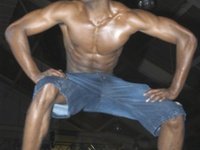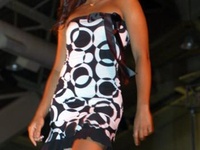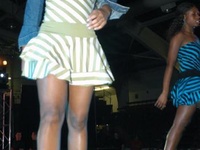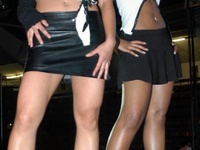As the bass beat of the walk-walk-walk-to-the-rhythm melody slinked throughout the crowd, revolving lights sparred with the continually transforming graphics on the video screen in eclectic tandem. An intoxicating dose of adrenaline and energy pulsed back and forth between the audience and the impossibly gorgeous figures onstage. On the evening of Friday, April 23, the only constant was the nostalgia-stimulant hip-hop roaring from the speakers, as the audience journeyed through four decades of pop culture fashion at Eleganza: Harvard’s annual spectacle of style.
There was not a seam to be seen in the diverse collection on the runway, nor any misstep in the execution of the multimedia display encompassing the 40-foot catwalk specifically designed for the production. The show’s organizers, student theater group BlackCAST, bypassed the typical runway venues in favor of a surround-sound multi-sensory experience of movement, expression and talent, creating what one crew member described as “a virtual playground.”
“Look, this is real, this is Harvard’s take on pop culture,” says the show’s creative director Jonathan R. Ardrey ’05. There are only a few hectic hours before Bright Hockey Center opens for the largest Eleganza production yet, and both he and executive producer Derek R. Melvin ’05 take a breather to reflect on their experience before dashing back down into the rink to survey the show’s sequencing.
“I watched Eleganza last year in Lowell Lecture Hall, and it was full, 400 people. Tonight, we have 1100 tickets sold out in the hockey rink,” says Melvin. “We wanted to bring it to another level, we wanted to push the envelope as far as it could go.” The push for a larger event was threefold, explains Melvin: more recognition for BlackCAST, lending a voice to talent that often goes unheard and just having fun.
“So many things here reach a specific audience,” Melvin says. “You have the theater for some people, classical concerts for others and cultural student groups that do their own thing, but this brings everybody together.”
As the show’s executive producer and creative director, respectively, Melvin and Ardrey are finally realizing a project eight months in production, forged from the collaborative vision of members of BlackCAST, a student staff, models, and professional clothing manufacturers. Originally begun 10 years ago, Eleganza has in recent years been building a reputation for its mélange of runway and theatrical performance. By far, this has been the most elaborate show yet, and model Sarah E. Johnson ’06, who performed in last year’s show, says there is a tangible difference.
“We were in a room packed with friends and it was more comfortable, because you knew everyone,” says Johnson. “But now, it’s less casual—you’re in front of 1300 people with a Jumbotron screen behind you.” Borrowed from Women In Color’s “Haute” show last semester, the video screen, coupled with computer graphics and sequenced sound, magnified the scope of the production tremendously. Although adding to the show’s high-stakes atmosphere, the visuals allowed for a look that previous producers could only dream of.
“One of the goals for this year’s show was to develop a unified aesthetic within a creative framework—one that would allow different media to be integrated into a fresh and exciting event,” says Ardrey. Deriving a more literal interpretation by dubbing this year’s theme, “Night at the Movies,” the show paid homage to the smooth synthesis of cinema with four separate themes: “Classic Hollywood,” “Blaxploitation,” “Boogie Nights,” and “80s Dance.”
Cinematic Extravagance
Eleganza’s program instructs the viewer to “watch as color and independence, originality and attitude come to dominate the red carpet.” The lights darken, a low rhythm reverberates and posed silhouettes signal the beginning of a two-hour flashback to icons of film culture, seeking to carry out the program’s promise.
The first sequence, “Classic Hollywood,” introduced an eclecticism borne of period-specific fashion and anachronistic music that was to run throughout the remainder of the show. Elegantly clad couples in dresses and suits reminiscent of 50s-era film noir strutted to the amplified beats of Method Man and Q-Tip, the crisp purity of the lights effectively evoking what the program called the “simple, clean and classic” characteristic of Hollywood’s early films.
In contrast with more routine runway shows that incorporate techno, lounge or jazz music at different points in the show, Eleganza’s musical range was strictly limited to straight hip-hop. The result was occasionally jarring, particularly at one point in “Hollywood,” when models paying homage to cinematic couplings of the 50s strutted to the R&B groove of Next’s “Wifey.”
The prevailing force of modern sensibility was also brought home with a kiss between models Nathalie Miller ’04 and Andrea H. Li ’04 a la Madonna and Britney Spears, which sent men and women alike to their feet and cameras flashing. Student dance company Expressions followed suit with a contemporary choreographed performance set to NERD’s fused rock-hop, featuring women in black cocktail dresses alongside men in suspenders and newsboy hats.
Pretenses of demure fashion established by “Hollywood” were quickly abandoned as the subsequent “Blaxploitation” theme evoked the sex appeal of the strong black male and female icons prevalent in popular 60s movies of the genre, such as Shaft and Foxy Brown. Revealing pieces from Wilson’s Leather, Planet Aid and Oona’s swayed and shimmered on bodies pulsating to the rhythm of “Sex Machine” and “Bad Mamma Jamma.”
The designers gave a nod to pimp fashion, an archetype of blaxploitation, in a sequence with bare-chested men reveling in the adulation of mini-skirted vixens. The segment’s tone was slightly marred by the off-putting notion that a production conscientiously pushing for racial diversity did little to challenge the film industry’s manipulative portrayal of African-Americans in the 1960s.
Another controversial paradox of the era, female empowerment through sexual authority, was illustrated in homages to Charlie’s Angels and Pam Grier. At least for the ladies, the paradox of simultaneous empowerment and objectification subtly prevailed, particularly in the striking Angels poses, a testament to “those strong, hot women who owned their sexiness.”
Topping off the steamy, holler-inducing sequence, the Caribbean Club Dance Troupe contributed a distinct tropical spice to their reggae-seasoned routine.
The raucous audience enthusiasm continued into the next theme of “Boogie Nights,” which celebrated the 70s theme of stylistic excess manifested in flashy clothes and absurdly over-the-top hairstyles. Noticeable throughout the show was the pairing off of couples of different ethnic backgrounds, and the multiracial aspect wasn’t lost on Ardrey and Melvin. Playing up the lame Caucasian stereotype, they directed David A. Wallach ’07 in vaulting himself through Studio 54’s velvet ropes, after which he was carried off the stage by Mike Beal ’06 and Jason W. Norman ’05.
The Harvard Steppers were also in full effect, sporting coordinated gray camouflage and only breaking their synchronized thunder to chant, “Get yo Jollies!” in anticipation of the Black Men’s Forum dance the following night.
But it was the final scene of the “80s Dance” that brought the crowd’s loudest reaction. The set was kicked off by Senior Class Marshall Shaka J. Bahadu ’04, who expressed his affection for the women in the audience and the floor with classic Prince eroticism, while Hank Wilkins ’04 suffered for glory in sporting the tightest jeans a man has ever had to wear while performing to “I Would Die 4 U.”
The Harvard Breakers Organization who were at Eleganza last year brought back the staple of a clubber’s diet in an incredible display of breakdancing from members such as James C. Lee ’06 and Brian D. Lee ’06. Particularly memorable was the show’s finale, which gathered all the models back on stage in their loudest period clothes to cheer on Kwame Owusu-Kesse ’06 and Nicholas H. Barnes ’05 as they mirrored each other in checkered leather jackets while dancing to Bel Biv Devoe’s “Poison.”
Models in theory but performers in practice, these students were clearly the centerpiece of the production, say Ardrey and Melvin.
“In Eleganza, we recognized a forum for creative expression that is not usually available at Harvard,” says Melvin. “We then set about collecting a team of amazing and talented individuals from a variety of backgrounds and experiences who rarely found outlets for their creative voices.”
The models found a space which allowed elegance and burlesque to thrive, often strutting the runway with the kind of seriousness befitting an haute couture show, then infusing their act with a jaunty cheekiness (particularly in the case of Ryan P. Lannon ’05, who at one point in the show, bared his assets).
“Having the models see the runway was such a rush too, because they’re amazing and they’re devoting their time, and time is the most important thing you can give here,” says Melvin.
A Family Affair
Combining a business savvy with creative ingenuity, the group called upon various financial and creative sources to support the $15,000 production. The main sources of funding were “partly the U.C. and sponsorships,” says BlackCAST treasurer Abdel Reid ’06, “but also ticket sales—the models just selling, being out there.”
The persistent campaigning translated into greater financial freedom for staff and crew—something that Ardrey found integral to situating Eleganza in its hockey-rink venue. “Just being able to have things like a movement specialist for the scenes, having someone just showing the models how to move allowed for so much more creativity,” says Ardrey.
“It was quite an intense process to get clothing from stores,” says fashion coordinator Tessa C. Petrich ’04. Using a leasing policy, the fashionistas of the production were able to borrow clothing in exchange for publicity, and the larger budget also allowed insurance policies to be taken out in order to “assuage the concerns of store owners.” All 70 models were measured, and the clothing picked out from various outlets such as Jasmine Sola, Cibeline, Hubba Hubba, Proletariat, and Planet Aid.
A crew of 30 assembled the open free-standing “U” on which the lighting was rigged, as well as the monstrous “I”-shaped stage, which supported a 40-foot long runway and a 48-foot wide mainstage. A more substantial budget also brought in companies such as East Coast Lighting to coordinate the complex light show and expand the creative boundaries of the show’s visual aspect.
The producers also hired Indigo Design Group to incorporate computer generated graphics onto the screen during the live show. Both the visual effects coordinator and the light board operator would be playing live, listening for the music cued up by Matthew T. O’Malley ’04, who utilized the same sequencing program used by Versace and Dolce & Gabbana in sequencing their music.
Many of the show’s organizers also appreciated the artistic freedom provided by the non-traditional venue. Aikis Konstantankopoulos ’06, who served as co-director with Manuela L.F. Zoninsein ’05 for the “Classic Hollywood” segment, says, “It’s just fun to direct the models, to bring all these different people from Harvard together and use lights, video and sound to create something different.”
The air is one of conviviality in the pre-show hours on Friday afternoon, and Melvin’s comment that “it’s just like family” seems prevalent above the hectic pace of last minute rehearsals. Though the producers intensified the rehearsal schedule to two to three hours per day for the final three weeks, students didn’t seem to mind, agreeing that the best part about the show is its people.
“There’s so much energy, and it’s a lot of fun,” says Nathalie Miller ’04, who also modeled in last year’s show. “People who you don’t think would do this are here, and there are all these different groups being brought together.”
A member of the Half-Asian Peoples’ Association, Miller is one of a diverse group of models who will represent groups such as the Black Student’s Association, the Association of Black Harvard Women and Men’s Varsity Basketball Team. Adds Abdel Reid, “You’ve got the Caribbean team, the BMF, finals clubs, black groups, Asian groups, and all these people are coming together to see their friends perform.” With the additional presence of the Men’s Varsity Hockey Team, who served as security for the night, the staff and crew were an eclectic mix of students that ultimately became family.
In the years ahead, BlackCAST would like to maintain the popularity of Eleganza as a way of challenging the traditionally rigid reputation that Harvard has of creating an unsupported artistic community.
“As pre-med and social studies majors, many members of our team wouldn’t normally get the chance to express their artistic sides,” says Melvin. “But Eleganza allows anyone with the talent and dedication to explore aspects of their own creativity that don’t have enough of an outlet at Harvard.”
—Staff writer Effie M. Metallidis can be reached at metallid@fas.harvard.edu.


















